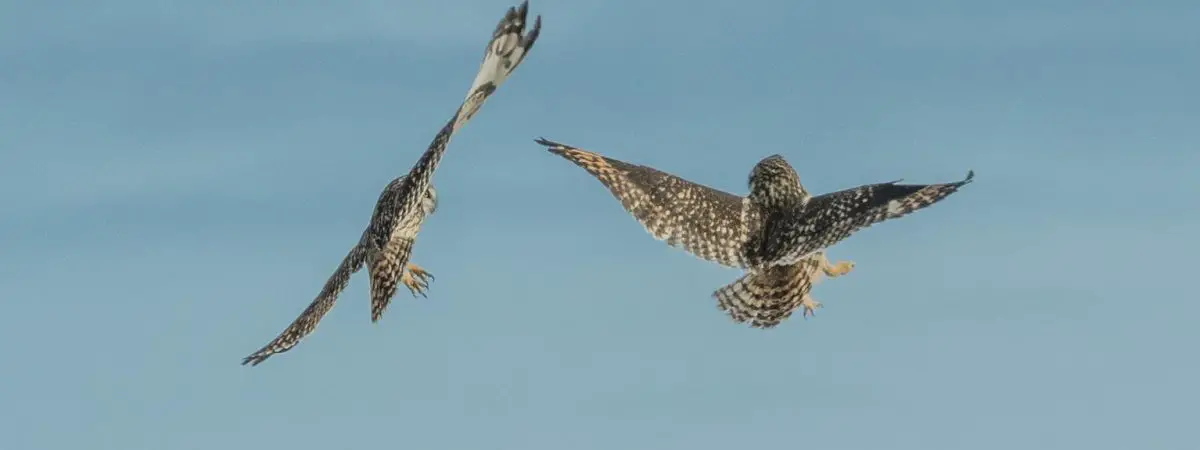
There are 11 owls that can be seen in Wisconsin. These are:
Table of Contents
Toggle- Great Horned Owl
- Barred Owl
- Eastern Screech Owl
- Northern Saw-Whet Owl
- Short Eared Owl
- Long Eared Owl
- Snowy Owl
- Burrowing Owl
- Northern Hawk Owl
- Great Grey Owl
- Boreal Owl
Want to learn more? This National Geographic Book on Owls is a great read!
The state of Wisconsin in the Unites States of America is home to a continental climate.
The summer months are warm, and the winter months are very cold. The temperatures vary between the north and the southern areas of the state, with annual temperatures ranging from 10oC in the southern areas to 4oC in the northern areas.
Wisconsin is home to a range of different habitats including bogs, swamps, marshes, wet meadows and wetlands.
The state of Wisconsin is home to thousands of small-scale ponds, fifteen thousand lakes inland and just under thirty-three thousand miles of streams and rivers.
There are sixty-six state parks located in the state of Wisconsin and these cover over sixty thousand five hundred and seventy acres.
The state of Wisconsin is home to eleven different species of owl.
Want to attract Owls to your yard? Take a look at our article!
What Owls can be seen in Wisconsin?
Table of Contents
1. Eastern Screech Owl
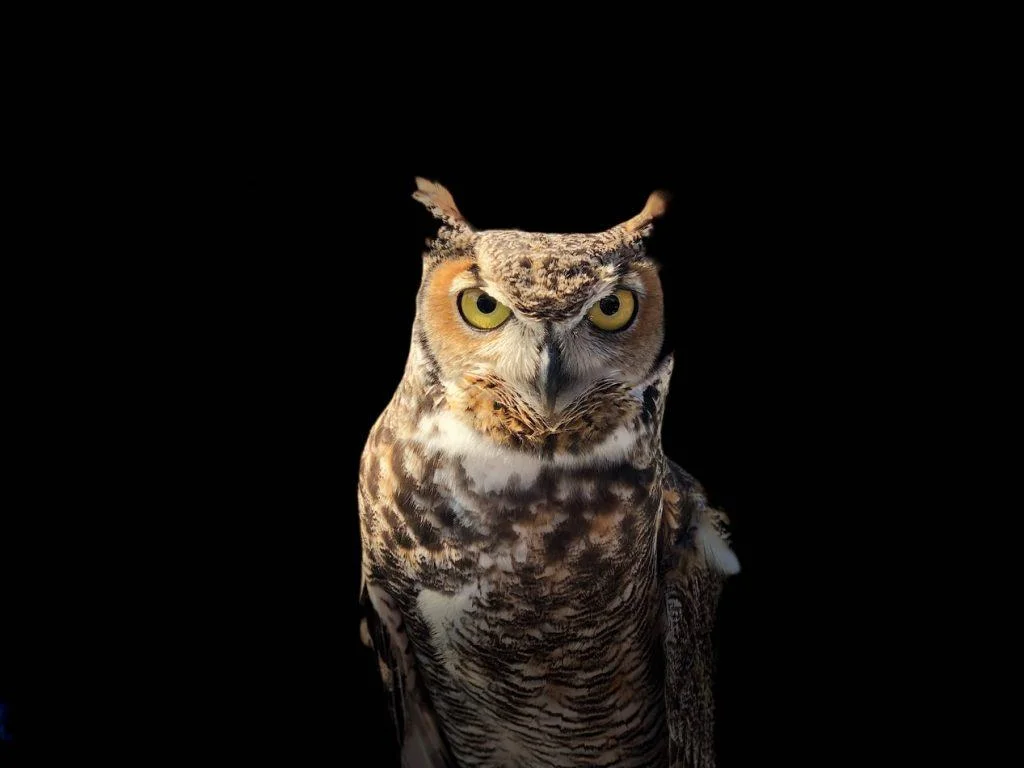
Wingspan
46 to 61 cm
Weight
160 g
Life Expectancy
14 years
Diet
Rats, Squirrels, Rabbits & Skunks
The Eastern Screech Owl is a very small species of owl that can be found in a range of different habitats across the state of Wisconsin.
The Eastern Screech owl is a nocturnal species of owl, so it spends the first few hours of darkness hunting, swooping and catching their prey from perches or sometimes hovering and diving quickly.
These owls tend to make their habitat in mixed open woodlands, deciduous forests, riparian woods, parklands, suburban wooded areas, wetlands, meadows, woodlands near marshes and mature orchards.
The Eastern Screech Owls are most commonly found to the east of the Rockies Mountain Range. The Eastern Screech owl is between sixteen and twenty-five centimetres in length.
The diet of this species tends to comprise of crickets, moths, beetles, large insects, however they have also been known to eat small birds, frogs, lizards, earthworms and small fish.
These owls breeding during April when the female lays a brood of between two and eight white eggs in the cavity of trees and will only leave briefly at dusk or dawn.
The Eastern Screech Owls can be found in the Cave of the Mounds National Natural Landmark, which is a designated cave.
2. Great Horned Owl
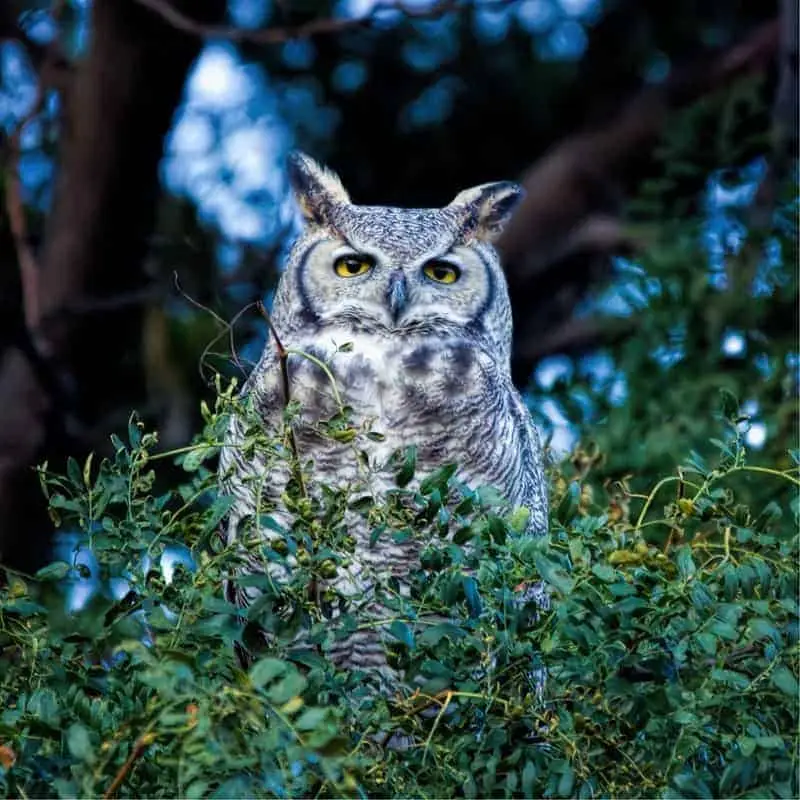
Wingspan
~140cm
Weight
1.4 kg
Life Expectancy
28 years old
Diet
Squirrels, Rabbits & Skunks
The Great Horned owl can generally be found around cliffs, canyons, woodlands and on the edge of forests.
These owls are one of the most seen raptor species in the state of Wisconsin. The great horned owl is between forty-six and sixty-four centimetres in length.
These owls can be found around farmlands and woods.
The diet of the Great Horned owls is mainly made up of mammals such as mice, rabbits and rats, however, they have also been known to eat birds up to the size of a goose, squirrels and skunks.
They will also eat lizards, frogs, insects, snakes and on the rare occasion will also take fish.
The Great Horned Owl is commonly seen around some of the state parks in Wisconsin and these parks include Big Hill Park, Big Foot Beach State Park and Milwaukee River Floodplain Forest State Natural Area.
The Great Horned owl lives in the state all year round and it mainly hunts at night as they are a nocturnal and solitary species.
3. Northern Saw-whet Owl
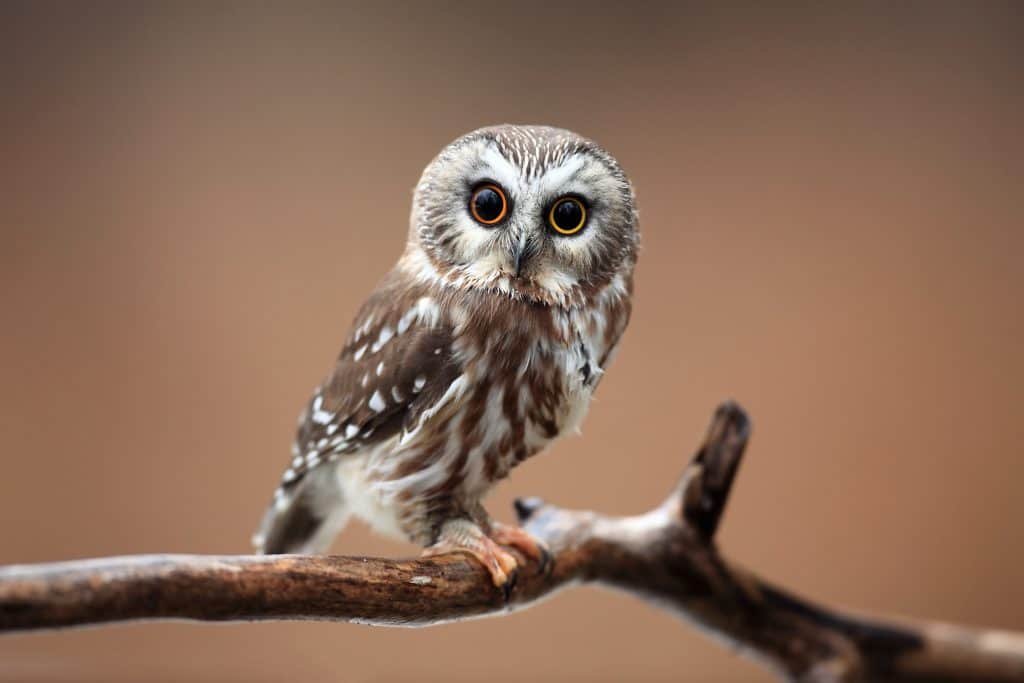
Wingspan
40 - 60 cm
Weight
100 g
Life Expectancy
7 years
Diet
Small birds, young squirrels, voles & shrews
The Northern Saw-Whet owl is the smallest owl in North America, and it is native to this area.
The Northern Saw-Whet owl tends to be between seventeen and twenty-two centimetres in length, which is only about the size of an American robin.
The adult Northern Saw-Whet owl tends to be a mottled brown colour with white streaks on their heads and a white v shape marking between their eyes on their round head and they do not have ear tufts.
The juvenile Northern Saw-Whet owls tend to have a cinnamon coloured belly and a brown back and the white marking between their eyes like the adults.
They prefer to make their habitat in areas with dense vegetation or in coniferous species and it is common for them to be found just at eye level, although it is not uncommon for them to be spotted twenty feet in the air.
During the day these owls will roost and then come out at night to catch their prey. The diet of the Northern Saw-Whet comprises of rodents and other small mammals.
4. Short-Eared Owl

Wingspan
85 to 110 cm
Weight
206–475 g
Life Expectancy
4-12 years
Diet
Voles, Mice, Squirrels
The Short-Eared Owl is a medium sized bird which tends to be between thirty-four and forty-three centimetres in length.
These owls have a big head with large eyes and a short neck. They have a short black bill which is hooked. Their feathers are a mottled tawny brown colour with barred wings and tail.
The Short-Eared Owl tends to make its nest on the ground, and they live in habitats such as meadows, tundra, prairie and savanna.
Their nests can be covered with low vegetation and it is not uncommon for the nest to be lined slightly with feathers, grass and weeds.
The diet of the Short-Eared Owls consists mainly of rodents with a favourite being voles. It is not uncommon for them to eat other small mammals such as ground squirrels, mice, bats, moles, muskrats, bats and shrews.
These are not a very common species around the state of Wisconsin, however, they have been spotted in some of the state parks including Scuppernong River Habitat Area, Scuppernong Prairie State Natural Area and they have also been spotted in Kettle Moraine State Forest – Southern Unit.
5. Snowy Owl

Wingspan
150 cm
Weight
2 kg
Life Expectancy
10 years
Diet
Birds, Rabbits, Fish & Rodents
The Snowy owl is a large white species with striking yellow eyes.
The adult males tend to vary in colour from pure white to white with brown spots whereas the adult females and the juveniles tend to be white with dark barring throughout their plumage except on the face.
The Snowy owl tends to be between sixty-three and seventy-three centimetres in length.
They tend to make their nests in arctic tundra areas with a slightly raised surface so that the wind will keep it free from snow.
It is common for a female snowy owl to raise ten young per nest and sometimes it can even be more than this.
The diet of the snowy owl mainly consists of small rodents with lemmings being one of the favourites.
It is not unknown for them to eat rabbits, fish and even birds. Every year there are at least some Snowy owls in the state of Wisconsin but is not one of the more common species in the state.
Most sightings of these owls have been during the winter months usually around November time. One of the best places for spotting Snowy Owls in the state of Wisconsin is around Oconto Harbour.
6. Long Eared Owl

Wingspan
90 to 100cm
Weight
250 g
Life Expectancy
4 years
Diet
Small mammals, mice, rats & rabbits
The Long-Eared Owl is a nocturnal species that is a secretive species and is well camouflaged against its habitat.
These owls can often be spotted flying during the spring and summer months. During the winter months, these owls roost in large numbers, therefore they are a lot easier to spot.
The Long-Eared owls are commonly between thirty-five and forty centimeters in length. These owls are a mottled gingery brown colour with white eyebrows are a distinctive feature above their striking orange eyes and they tend to have large ear tuffs which raise when the owl is alarmed.
These owls tend to make their habitats in areas of coniferous or mixed woodlands which has dense cover and hedgerows.
The diet of the Long-Eared owl tends to consist of small mammals such as mice, voles and small birds. When they are hunting, they will swoop down through open country flying in a zig-zag pattern whilst searching for food.
The Long-Eared Owl can be seen in the state of Wisconsin all year round and one of the best places to spot them is Brooklyn State Wildlife Area.
7. Northern Hawk Owl
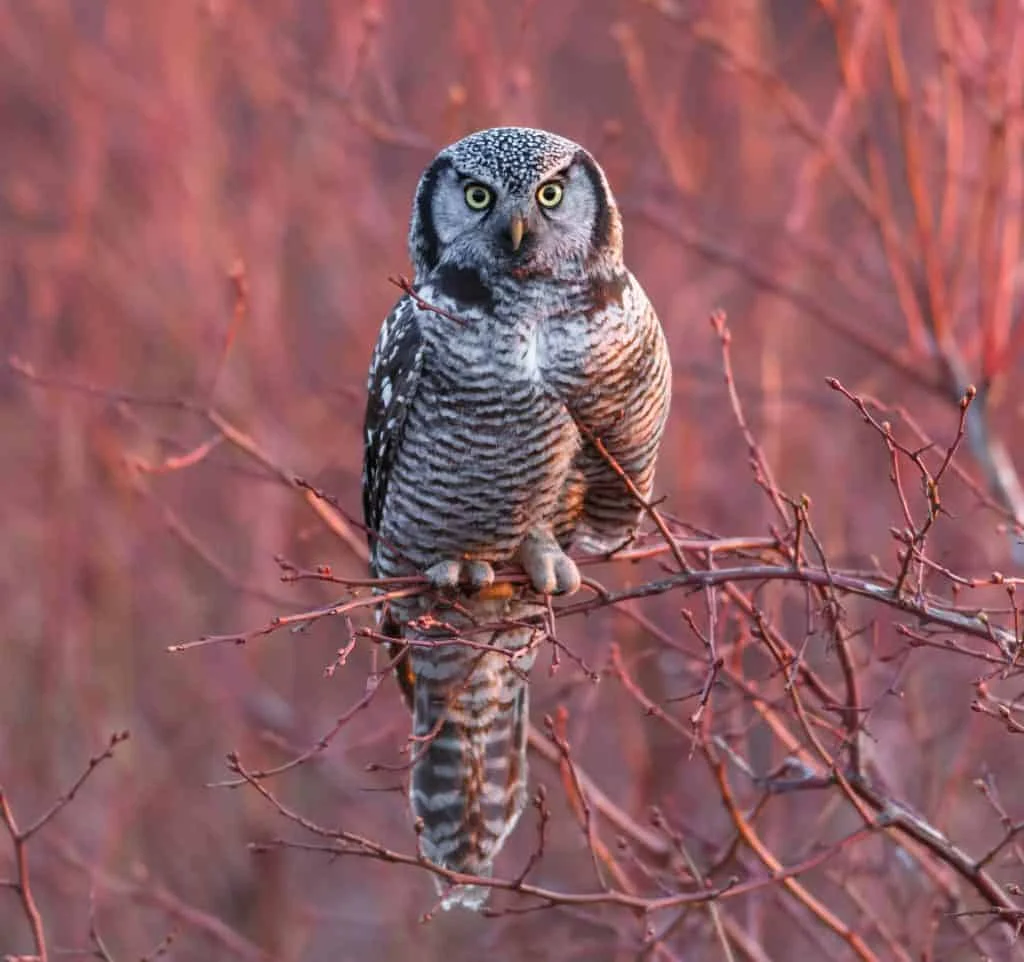
Wingspan
45 cm
Weight
300 -340 g
Life Expectancy
Up to 16 years
Diet
Rodents & Small Mammals
The Northern Hawk owl is not a species that is evenly distributed, and their population varies across the Boreal Forest.
These owls tend to prefer areas of open coniferous forest or mixed forest with deciduous and coniferous species. The Northern Hawk Owl tends to between thirty-six and forty-five centimeters in length with the females being slightly bigger than the males.
Both the males and females have a wingspan of about forty-five centimeters. The diet of the Northern Hawk owl mainly consists of small mammals with a high proportion of voles and rodents, but it is not uncommon for them to eat other small birds.
The Northern Hawk owl is an uncommon visitor to the state of Wisconsin however it is not unknown for it to be seen in the state.
8. Great Grey Owl

Wingspan
Up to 152cm
Weight
1.1 kg
Life Expectancy
12 years old
Diet
90% small rodents
The Great Grey Owl tends to have a silvery-grey plumage with fine streaks of white, streaks of brown and faint bar markings.
This species of owl has bright yellow eyes and a fine grey circular face with two pale arches that form an X shape between the eyes.
These owls tend to be between sixty-one and eighty-four centimeters in length with a wingspan between one hundred and forty and one hundred and forty-two centimeters, however it is not uncommon for the wingspan to be as large as one hundred and fifty-two centimetres.
The Great Grey Owl tends to be found in dense coniferous forest areas.
These owls prefer to make their nest in large fir or pine trees in areas that are far away from human development.
Most of the diet that is consumed by the Great Grey owl consists of small rodents, however it is not uncommon for them to eat voles, weasels, rabbits, mice, squirrels and even some birds including ducks, grouse and thrushes.
The Great Grey Owl is not a commonly seen owl in the state of Wisconsin however they have spotted from time to time during the winter months.
One of the best places to look for a Great Grey Owl is at Willow Flowage, as this area is known for attracting a large proportion of winter and spring migratory birds.
9. Boreal Owl

Wingspan
50–62 cm
Weight
120 g
Life Expectancy
16 years
Diet
Small mammals, birds & insects
The Boreal Owl is a small owl that has a brown coloured plumage with white specks across the shoulders.
The under part of their body has white streaks with a rusty colour. The Boreal Owl tends to be between twenty-one and twenty-eight centimetres in length with a wingspan of between fifty and sixty-two centimetres.
They have a large head with bright yellow eyes and disc-shaped face which is white in colour. The Boreal Owl prefers to make its home in montane or boreal forest or other deciduous forests where there are plenty of tall trees such as spruce, pine and birch.
The diet of the Boreal Owl mainly consists of mice and voles, but they have been known to eat a range of other things including shews, small squirrels, pocket gophers, insects and small birds.
These are a rather shy species of owl therefore tend to be completely nocturnal.
The Boreal Owl is not a very common species within the State of Wisconsin however it is not uncommon for them to be spotted within the state especially during the winter months when it becomes difficult for them to find enough food in the Boreal area.
10. Burrowing Owl

Wingspan
51-61 cm
Weight
140-240 g
Life Expectancy
10 years
Diet
Large Insects and Small Rodents
The Burrowing Owl is a ground-dwelling species that tends to be between nineteen and twenty-eight centimeters in length.
These owls have a sandy brown body with white spots, long legs, and bright yellow eyes, but they do not have ear tufts.
The burrowing owl makes its habitat in underground burrows, and it is not uncommon for them to take over a burrow from another species such as ground squirrel, tortoise, or prairie dog.
The burrowing owl tends to live in deserts, grasslands, and other open habitats. The diet of the burrowing owl consists mainly of small mammals, reptiles, amphibians, insects, and other birds.
They are most active at dusk and dawn however it is not uncommon to see them out during the day, as this is when they will catch most insects.
The population of burrowing owls across the state of Wisconsin has decreased over recent years due to the loss of habitat to the point where they are classed as endangered in some areas but there are still some in the state so you may be lucky enough to spot one.
Some of the best places to spot the Burrowing Owl is in the state parks such as Crex Meadows.
11. Barred Owl

Wingspan
96-125 cm
Weight
468-1,150 g
Life Expectancy
10-23 years
Diet
Small mammals
The Barred Owl is a widespread species that is fairly common although numbers have decreased in southern areas due to the loss of swamp areas. The eyes of these owls are their secret weapons as it helps with detecting prey.
The Barred owl is between forty-eight and fifty-one centimetres in length. Theses owls tend to make their habitats around large mature forests that are home to a combination of evergreens and deciduous tree species, and they can often be found living near water.
The Barred Owls often make their nests in the cavities of trees. The diet of the Barred owl tends to consist of small rodents; however, it has also been known to eat birds, frogs, snakes, lizards, small mammals such as shrews and rabbits.
These owls are around the state all year round, but they will be easier to spot around February and March time.
Around the state of Wisconsin, the Barred Owl can be found in some of the state parks including Pine Island State Wildlife Area, Pheasant Branch Conservancy, University of Wisconsin Arboretum, Yellowstone State Wildlife Area and Big Hill Park.

More Articles.

What does it mean to see an Eagle flying in your dream? (Symbolism and Meaning)
The eagle is a powerful animal that symbolizes freedom, strength, and authority. Seeing an eagle

Bird baths can offer your local birds a place to hang out and a nice

How to Attract Geese to Your Yard?
As far as birds go, geese get some fairly mixed reviews. These large birds aren’t

About Us
We are avid bird-watchers who recently retired, allowing us more time to travel the world. Fortunately, we have managed to visit numerous countries around Europe, Asia, and America. Watching and photographing birds has been a passion for many years and we are making the most of the extra time on our hands!

